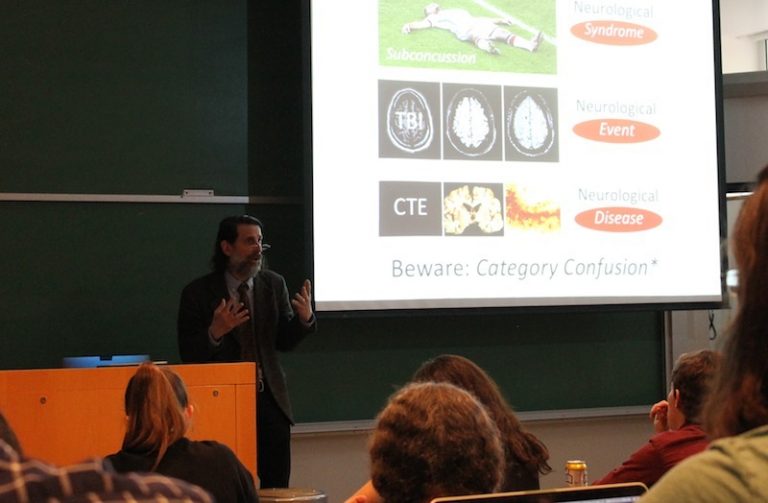Pioneering Expert on Brain Injury and Disease Visits Bowdoin
By Rebecca Goldfine
John Pietro ’18, a biology major, invited the doctor and associate professor to campus. Before he launched into his talk, Goldstein encouraged Bowdoin students to seek out research opportunities in his lab at Boston University School of Medicine.
Goldstein and his team have revealed an important distinction between concussions and CTE, which is a progressive brain disease that leads to dementia. That is, people who develop CTE do not necessarily have a history of concussions. A soldier exposed to shock waves from a bomb blast is at risk for developing CTE, as is an athlete whose head has sustained repeated impacts.
“About 20 percent of the our cases have no case history of concussion, yet they have CTE,” Goldstein said. Once CTE is triggered, it spreads throughout the brain, killing brain cells — even if the brain is not injured again.
Goldstein warned that this finding is controversial. “But it shouldn’t be,” he emphasized, as it is based on years of rigorous experiments.
In his lab, Goldstein has found that mice, when they are exposed to bomb-like blasts, do not get concussed. “We didn’t see any effects [in the mice brains], no bleeding or hemorrhaging, their brains look normal. Only they aren’t normal, they are profoundly abnormal,” he said.
Instead the mice end up developing the distinctive brain pathologies of CTE days, weeks, or months after undergoing the blast trauma, as well as associated behaviors. CTE symptoms in humans include impulse control problems, aggression, depression, memory loss, confusion, and impaired judgment.
Remarking that some soldiers returned from service are being denied medical care after complaining of symptoms associated with brain trauma, Goldstein said he sees his work as “a moral imperative.” “I am going to explain to that grieving mother and tell her her son died because his brain was injured and he was not malingering,” he said. “This is very helpful for people to understand this, and very helpful for a clinician to explain what is happening to patients.”
He called CTE “not just a sports problem” but a “public health problem of worldwide dimensions.” Besides veterans and athletes, populations at risk of CTE include the homeless, domestic violence victims, the incarcerated, and the chronically mentally ill. “And we don’t think it’s rare. This is not rare.”
Goldstein’s lab is working on determining why blasts and sub-concussive, repetitive blows to the head can lead to CTE, which is characterized by the slow spread of Tau protein throughout the brain, damaging blood vessels and causing neuroinflammation.
While he stressed the importance of prevention (“don’t put yourself in harm’s way,” he said), Goldstein also spoke of strides his lab has taken in developing a therapeutic antibody that can treat the brain at the site of injury. “We’re already doing clinical trials right now,” he said. “Not only are we learning about a new disease, but we’re almost at a point where we can start diagnosing it and treating it.”



